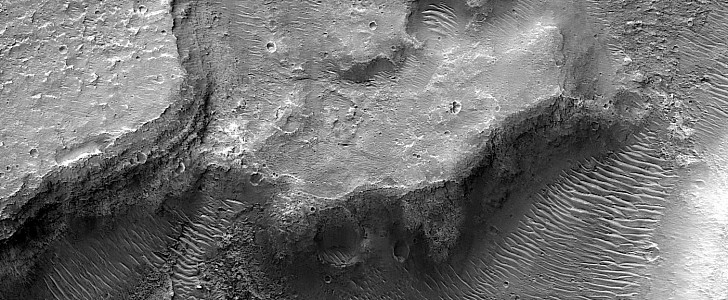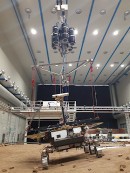Never in the history of humankind did a conflict here on Earth affect our species’ common goal of exploring and expanding into outer space. Until this year, that is, when Russia’s invasion of Ukraine did just that.
The conflicting views of our world’s order between East and West have expanded upward, and are now impacting space exploration. One of the planned missions that got scrapped, at least temporarily, on account of the conflict, is the European ExoMars.
The continent’s first mission meant to deliver a rover to Mars (called Rosalind Franklin), ExoMars was supposed to launch this year on top of a Russian Proton rocket, but because it’s no longer possible to carry out “the ongoing cooperation with Roscosmos,” ESA’s higher-ups decided to postpone the mission at least until 2023.
The Franklin was supposed to search for signs of life on the neighboring planet, including near the region shown in the main photo of this piece.
The pic, recently released by the University of Arizona, which runs together with NASA the HiRISE camera floating in orbit around Mars, shows a place called Coogoon Valles, close to “one of the top-ranked landing sites for ExoMars.” The region is of particular interest because the feature shown here is of unknown origin. It may have been caused by a collapse, but it might just as well have been a “caldera formed through ancient explosive eruptions.”
Also, the thinner crust in the region would have made it a suitable candidate for the search of alien life.
The mission’s official landing site is called Oxia Planum, a place with “one of the largest exposures of rocks on Mars,” 3.9 billion years old and rich in clay, which points to it being once home to water, just like neighboring Coogoon.
As it stands, with ESA still looking for a launch vehicle, the region will remain unexplored from the ground for a while longer.
The continent’s first mission meant to deliver a rover to Mars (called Rosalind Franklin), ExoMars was supposed to launch this year on top of a Russian Proton rocket, but because it’s no longer possible to carry out “the ongoing cooperation with Roscosmos,” ESA’s higher-ups decided to postpone the mission at least until 2023.
The Franklin was supposed to search for signs of life on the neighboring planet, including near the region shown in the main photo of this piece.
The pic, recently released by the University of Arizona, which runs together with NASA the HiRISE camera floating in orbit around Mars, shows a place called Coogoon Valles, close to “one of the top-ranked landing sites for ExoMars.” The region is of particular interest because the feature shown here is of unknown origin. It may have been caused by a collapse, but it might just as well have been a “caldera formed through ancient explosive eruptions.”
Also, the thinner crust in the region would have made it a suitable candidate for the search of alien life.
The mission’s official landing site is called Oxia Planum, a place with “one of the largest exposures of rocks on Mars,” 3.9 billion years old and rich in clay, which points to it being once home to water, just like neighboring Coogoon.
As it stands, with ESA still looking for a launch vehicle, the region will remain unexplored from the ground for a while longer.














